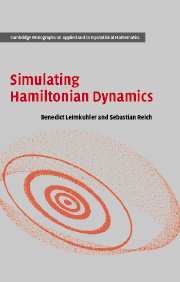Book contents
- Frontmatter
- Contents
- Preface
- Acknowledgements
- 1 Introduction
- 2 Numerical methods
- 3 Hamiltonian mechanics
- 4 Geometric integrators
- 5 The modified equations
- 6 Higher-order methods
- 7 Constrained mechanical systems
- 8 Rigid body dynamics
- 9 Adaptive geometric integrators
- 10 Highly oscillatory problems
- 11 Molecular dynamics
- 12 Hamiltonian PDEs
- References
- Index
6 - Higher-order methods
Published online by Cambridge University Press: 04 December 2009
- Frontmatter
- Contents
- Preface
- Acknowledgements
- 1 Introduction
- 2 Numerical methods
- 3 Hamiltonian mechanics
- 4 Geometric integrators
- 5 The modified equations
- 6 Higher-order methods
- 7 Constrained mechanical systems
- 8 Rigid body dynamics
- 9 Adaptive geometric integrators
- 10 Highly oscillatory problems
- 11 Molecular dynamics
- 12 Hamiltonian PDEs
- References
- Index
Summary
In Chapter 4, we introduced several first- and second-order symplectic integration methods for Hamiltonian systems. In this chapter, we will discuss the construction of “higher-order” symplectic methods (with order greater than two), focusing in particular on those types of schemes that have been found to be most useful for practical computations. In traditional practice, higher-order integrators are employed for solving problems with relatively smooth solutions, such as gravitational simulations (solar system simulations, satellite trajectories). They are also traditionally used for many types of computations when very high accuracy (for example near the rounding error of the computer) is desired.
As we have seen in Chapter 2, the appropriateness of a given numerical method for a given computational task is a complicated issue. In some cases, the principles of geometric integration are in contradiction with the demand for high accuracy. If the purpose of simulation is to reconstruct, as exactly as possible, a particular trajectory segment, it may not matter what sort of qualitative features the integrator possesses: the efficiency of the integration method in terms of solution error per unit work is instead of paramount importance. Since the development of symplectic integrators adds a number of additional constraints on the design of the method, such schemes typically sacrifice something in efficiency compared with their nonsymplectic counterparts at similar accuracy, for example requiring an extra force evaluation or two at each timestep. Thus the problem of correctly determining the precise entry point and time instant that a space probe arrives at the Martian atmosphere is a task best handled by a standard integration method, for example, a high-order multistep integrator (for example, Diva) or explicit Runge–Kutta method (for example, RKSUITE).
- Type
- Chapter
- Information
- Simulating Hamiltonian Dynamics , pp. 142 - 168Publisher: Cambridge University PressPrint publication year: 2005



